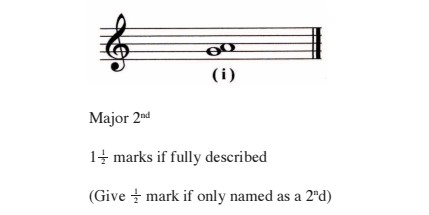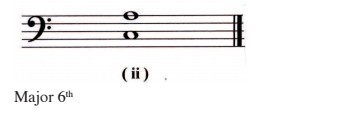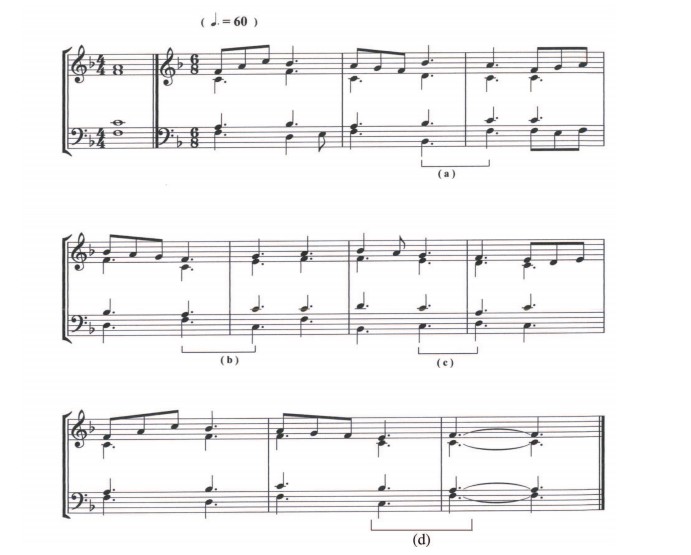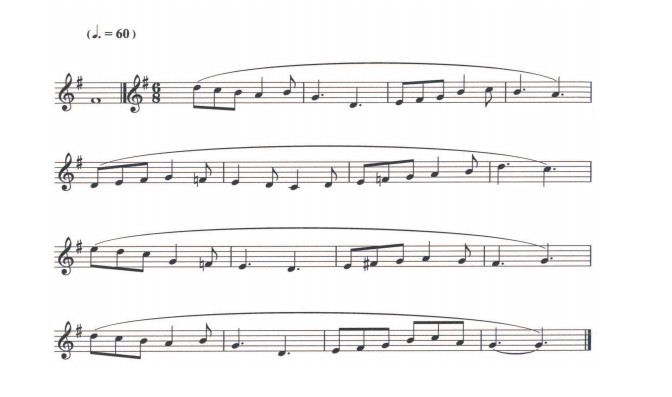KCSE Past Papers Music 2014
Click Here - Free KCSE Past Papers » KCSE Past Papers Music 2014 » Free Downloads » KCSE Papers & Marking Schemes
TEST ONE: Rhythm ON MONOTONE
Test 1 (a) Drum Rhythm
You are to write on monotone tlle rhythm of the following repetitive drum pattern.
You are required to add time signature and bar lines and also group the notes.
The rhythm pattern will be played four times.
Here is the crotchet pulse followed by the first play through.
(Pause: 2 seconds)

Here is the second play through
(Silence: 30 seconds)
Here is the third play through
(Silence: 30 seconds)
And now, the fourth and last play through
(Silence: 60 seconds)
Test 1 (b) Rhythm of a melody in simple time.
You are to write the rhythm of the following melody on monotone, adding the time signature.
It begins on the first beat of the bar
The melody will be played four times
Here is the crotchet pulse followed by the first play through
(Pause: 2 seconds)

Here is the second play through
(Silence: 30 seconds)
Here is the third play through
(Silence: 30 seconds)
And now, the fourth and last play through
(Silence: 60 seconds)
Test 1(c) Rhythm of a melody in compound time.
You are to write the rhythm of the following melody on monotone adding the time signature and bar lines. It begins on the last beat of the bar. The melody will be played four times.
Here is the dotted crotchet pulse followed by the first play through.
(Pause: 2 seconds)

Here is the second play through
(Silence: 30 seconds)
Here is the third play through
(Silence: 30 seconds
And now, the fourth and last play through
(Silence: 60 seconds)
TEST TWO: MELODY
Test 2(a): Melody in a major key
You are to write the following melody in the key of F major. The melody will be played through once, then the first phrase will be played twice and the second phrase twice. Finally the whole melody will be played right through once again. Write the treble clef and the key signature of F major now.
(silence: 10 seconds)

And now, here is the tonic chord and key-note again followed by the first phrase.
(Silence: 40 seconds)
Here is the first phrase again.
(Silence: 40 seconds)
Now here is the keynote and the second phrase.
(Silence: 40 seconds)
Here is the second phrase again.
(Silence: 40 seconds)
Finally here is the tonic chord followed by the whole melody.
(Silence: 60 seconds)
Test 2(b) Melody in a Minor key
You are to write the following melody in the key F sharp minor. The melody will be played through once, then the first phrase will be played twice and the second phrase twice. Finally the whole melody will be played right through once again. Write the treble clef and the key signature of F sharp minor.
(Silence: 10 seconds)
The melody is in 4 time. Write the time signature now.
4
(Silence: 10 seconds)
The melody begins on the last beat of the bar. Here is the dotted crotched pulse.
(Pause: 2 seconds)
(Pause: 2 seconds)
Here is the tonic chord of F sharp minor and the key note followed by the whole melody.
(Pause:2 seconds)
(Silence:40 seconds)
And now, here is the tonic chord and key-note again, followed by the first phrase.
(Silence: 40 seconds)
Here is the first phrase again.
(Silence: 40 seconds)
Now here is the keynote and the second phrase
(Silence: 40 seconds)
Here is the second phrase again.
(Silence: 40 seconds)
Finally, here is the tonic chord and the keynote, followed by the whole melody.
(Silence: 60 seconds)
TEST 3: INTERVALS
Two intervals will be sounded harmonically. Each interval will be sounded twice.
You are to describe each of the intervals.

Here is the second interval again.
(Silence: 20 seconds)
TEST 4: CADENCES
There are four cadences in this passage which will be played with a pause at each cadential point. You are required to name the cadences in the order in which they occur in the passage.
Here is the tonic chord followed by the first play through.

Here is the second play through.
(Silence: 15 seconds)
Here is the third play through
(Silence: 15 seconds)
And finally the fourth and last play through.
(Silence: 20 seconds)
TEST FIVE: MODULATION
Test 5 (a)
The following melody is in the key of G major. The melody modulates once way from the tonic key. You are required to name the key to which the melody modulates before returning to the tonic. The melody will be played three times.
Here is the key note of G major followed by the first play through.
(Pause: 2 seconds)

Here is the second play through.
(Silence: 15 seconds)
And now the third and final through.
(Silence: 30 seconds)
Test 5 (b)
The following melody is in the key of F minor. The melody modulates once away from the tonic key. You are required to name the key to which the melody modulates before returning to the tonic. The melody will be played three time. Here is the key note of F minor followed by the first play through.

Here is the second play through.
(Silence: 15 seconds)
And now, the third and final play through.
(Silence: 30 seconds)
That is the end of the Aural Tests of the Kenya Certificate of Secondary Education. Music examination
You now have five minutes in which to check your answers before handing in your paper.
3.28.2 Music Paper 3 (511/3)
SECTION A: BASIC SKILLS (32 marks)
1. Either
(a) Continue the following opening to make a melody of 16 bars for voice, incorporating a sequence and a duplet. Modulate to the relative minor before returning to the tonic key. (12 marks)

(b) Using the text below, compose a melody in staff notation. Add phrase marks to indicate cadencial points. (12 marks)
Mambo hayaji kwa nguvu
Wala kwa hila, sikia
Vumilia ule mbivu
Omba Mungu na ngojea
2. Hannonize the following melody for Soprano, Alto, Tenor and Bass (SATB). Choose appropriate chords from the following: l, ll, IV, V and VI. Cadential progressions have been provided. (20 marks)

3. AFRICAN MUSIC
(a) (i) Identify the community that plays each of the following traditional instruments. (2 marks)
Ibirandi .......................
Kigamba.......................
Nzuga.......................
Chimbengele .......................
(ii) Name the scientific classification of the instruments in (i) above
(b) Outline four functions of song text in African traditional dances.(4 marks)
(C) Ramogi is a Kenyan traditional dance from the Luo community.
(i) Name the occasion when the dance is performed. (1 mark)
(ii) Name three instruments used in the dance. (3 marks)
(d) For each of the following dances, name the community that performs it.(3 marks)
(i) Lelemuma .......................
(ii) Hella .......................
(iii) Kiveve .......................
4 WESTERN MUSIC
(a) William Byrd
(i) In which period of music history did William Byrd live?
(ii) Outline three of his achievements jointly with Thomas Tallis. was against it?
(iii)How did Byrd manage to hold on to his Catholic faith in an environment that? (2 marks)
(iv) What does “My Ladye Novelles Booke" contain? (1 mark)
(b) Alessandro Scarlalli
(i) What was Alessandro Scarl1atti’s nationality? (1 mark)
(ii) Outline two sources that influenced Scarlatti’s music education background. (2 marks)
(iii) What is an Overture?
(iv) With reference to tempo, state the plan of Scarlatti’s Overture. (1 mark)
(v) Describe the form of Arias in his Opera. (2 marks)
(c) Joseph Haydn
(i) What is an Oratorio? (1 mark)
(ii) Name the titles of Haydn ’s two most popular Oratorios? (1 mark)
(iii) What inspired Haydn to write the two Oratorios? (1 mark)
(iv) Explain the significance of patronage in the success of Haydn’s musical career.(4 marks)
(d) Antonin Dvorak
(i) What type of work is “From the New World”? (1 mark)
(ii) State four characteristic features that give the Work in (i) above its popularity.(4 marks)
(iii) Outline Dvorak’s career appointments during the following periods:
5. PRESCRIBED TRADITIONAL AFRICAN MUSIC
Borana Folk Dance by Gitabini Secondary School(KMF Recording).
(a) Describe the sequence of activities in the introductory section. (2 marks)
(b) Describe the singing style in the performance. (3 marks)
(c) Name two vocal ornaments employed in the performance. (2 marks)
(d) State how the rhythm is marked and sustained throughout the performance. (2 marks)
(e) Describe the ending of the performance. (1 mark)
6. PRESCRIBED WESTERN MUSIC
Contrapuctus 4 from The Art of Fugue By J . S. Bach
(a) With reference to bar numbers, give examples of:
(i) Tonic pedal (1 mark)
(ii) Scalic movements that form a complete scale. (2 marks)
(iii) Tierce dc Picardie. (1 mark)
(b) Which fugal device describes the entry in bar 5? (1 mark)
(c) Describe the key scheme in reference to the following sections:
(i) Bars 44 to 52. (2 marks)
(ii) Bars 125 to 130. (2 marks)
(d) Which device has the composer used to create syncopation throughout the work? (l mark)
SECTION C: GENERAL MUSIC KNOWLEDGE (20 marks)
7 (a) Define each of the following
(i) Symphony ..................................(l mark)
(ii) Piano Quintet ............................(l mark)
(m) Word Painting .............................(l mark)
(iv) Gregorian chant ..........................(l mark)
(b) Identify each of the following as either transverse or oblique flute.
(1)Muturiru.............................. (½ marks)
(ii)Aulem.............................. (½ marks)
(111) Ekibiswi .............................. (½ marks)
(iv) Biringi .............................. (½ marks)
(v) Ndurerut ............................... (½ marks)
(vi) Chivoti .............................. (½ marks)
(c) (i) State two elements of a song. (2 marks)
(ii) Identify three features that distinguish Adeudeu from Litungu. (3 marks)
(d) Refer to the melody below and describe its general features listed.

(ii) Tonality ..........................(1 mark)
(iii) Phrasing ..........................(1 mark)
(v) Range ..........................(1 mark)
(vi) Meter ..........................(1 mark)
(vii) Dynamics ..........................(1 mark)
(viii) Ending ..........................(1 mark)
(iv) Texture ..........................(1 mark)
4.28 MUSIC (511)
4.28.1 Music Paper 2 (511/2)
TEST 1
l. (a) Drum rhythm

½ mark for correct barring (½ mark)
½ mark for correct time signature (½ mark)
Total (4 marks)
(b) Rhythm of a melody in simple time

l mark for the correct time signature (1 mark)
l mark for correct barring (mark as a whole) (1 mark)
Total (8 marks)
(c) Rhythm of a melody in compound time

Time signature (½ mark)
Total (8 marks)
TEST 2: MELODY
2. (a) Melody in a major key.

(b) Melody in a minor key

TEST 3 : INTERVALS
(i)



(b) Imperfect - (1 mark)
(c) Interrupted - (1 mark)
(d) Perfect - (1 mark)
Total - (4 marks)
TEST 5 : MODULATION

i.e subdominant

*Award % mark only for naming relationship only
i.e Relative major
4.26.2 Music Paper 3
l. (a)
16 bars 1 mark
Lyricism (singability) - within voice range 2 marks
Modulation (well established)
- 1 mark for the new key
- l mark for the return to the tonic) 2 marks
Cadences (any 2 including the final perfect cadence) 2 marks
Sequence l mark
Duplet l mark
Phrasing- (2 bar phrasing) 1 mark
Melodic curve and climax l mark
Rhythm (variety, conformity) 1 mark
Total 12 marks
(b)
Text setting to music (speech rhythm/accents
(½ mark for each line) 2 marks
Rhythm variety (mark as a whole) l mark
Lyricism 2 marks
Cadences (1 mark each for any 2 including the final) 2 marks
Suitable time signature 1 mark
Melodic curve/climax/shape 1 mark
Syllabic division (½ mark for 15' two lines, ½ mark for next two) l mark
Phrase marks (as a whole) l mark
Musicianship/creativity (choice of key, performance instructions,
Word painting) l mark
Total 12 marks
2. Award marks as follows:
Chords - ½ mark for each correct chord 7 marks
Voice leading (1 mark for each voice- ATB) 3 marks
Correct cadences at the end of each phrase- 1 mark each 2 marks
Voice range - mark as a whole l mark
Progression (devoid of faults) 7 marks
Deduct l mark each for any of the following faults (maximum deduction 7 marks)
Consecutive perfect Sths l mark each
Parallel octaves 1 mark each
Crossing of parts l mark each
Spacing 1 mark each
Doubled 3rds in major chords l mark each
Doubled leading note l mark each
Wrong use of 2nd inversion chords or six- four chords l mark each
Wrong rhythms (mark as a whole) l mark
Stems (mark as a Whole) l mark
Exposed Sths or 8ves 1 mark each
From unison to Sths or 8ves and vice versa 1 mark each
Overlapping l mark
Others — missing clefs, key signature, Wrong note values,
missing double bar lines, missing brace, l mark each
If more than half the chords are wrong then no hannony
Total 20 mark
SECTI ON B: HISTORY AND ANALYSIS (48 MARKS)
AFRICAN MUSIC
3. (a) (i)
½ mark each for each correct community = 2 marks
(ii) ldiophones l mark
(b)
1 mark each for any four correct functions =4 marks
(c) (i) Funeral/Entertainment/commemoration/celebrations 1 mark
(ii) Bul, Oporo (Tung), Ajawa (Puga), Asili, Gara, Abu,
1 mark each for any 3 relevant instruments 3 marks
(d) (i) Swahili 1 mark
(ii) Somali 1 mark
(iii) Akamba 1 mark
4. WESTERN MUSIC
(a) William Byrd
(i) Renaissance 1 mark
(ii) - Given monopoly of printing and selling music for 20 years
- Appointment as organist at Chapel Royal
- Published a collection of Latin Motets Cantiones Sacrae.
1 mark each
(iii)- His service to the Anglican Church as an organist
- His closeness to the Queen/Loyalty to the Queen
- His several English compositions especially for the Anglican Church
- His being a fine musician made him to be respected
- Most of the Catholic music was for private use
2 marks for any relevant point 2 marks
(iv) A collection of 42 of Byrd’s keyboard/virginal pieces produced under his supervision
(b) Alessandro Scarlatti
(i) Italian/Sicilian 1 mark
(ii) - Born in a family of musicians.
- Studied music in Rome/ studied music with Giocomo Carissimi
- He was a choir boy at the local church
- He learnt rudiments of music from Bamardo Pasquini
1 mark each for any two relevant points = 2 marks
(iii) Piece of orchestral music preceding an opera or oratorio 1 mark
(iv) Quick - slow — quick (fast - slow- fast) 1 mark
(v) ln ternary form (ABA) but with the first two sections written out, with the use of D.C. at the end/Da capo aria 2 marks
(c) Joseph Haydn
(i) Large scale composition for chorus, vocal soloists, and orchestra, set to narrative text based on biblical stories. 1 mark
(ii) - The Seasons
- The Creation
½ mark each total 1 mark
(iii) Hanclel’s oratorios/works l mark
(iv) - Steady income
- His works were performed regularly
- Access to music publishing
- Organization of a workable schedule
- Availability of performance facilities
- He received encouragement and approvals
- He had opportunities to experiment
- As a composer he became more original
1 mark each for any 4 relevant points 4 marks
(d) Antonin Dvorak
(i) A symphony 1 mark
(ii) - Use of syncopation
- Use ofmodal scales
- Use of pentatonic scales
- Colourful orchestration and thematic material
- Contrasting movements with the use of thematic material
- Merging the black American spiritual music and the Czech folk music
1 mark each for any 4 relevant points 4 marks
(iii) 1892 - 1895 in New York - Director of National Conservancy of Music 1 mark
(iv) 1901 - 1904 in Prague - Director of Prague Conservancy l mark
5. PRESCRIBED AFRICAN TRADITIONAL MUSIC
(a) - Drumming
- Ululation
- Singing
- Chanting
- Clapping
2 marks for the first two in sequence 2 marks
(b) - Call-response
- Female soloist with a mixed choral response
- Male soloist with a mixed choral response
- Unison singing
- Overlap between the soloist and choral response
- Repetition of parts
- Chanting
1 mark each for any 3 relevant styles 3 marks
(c) - Vocal interjections
- Ululations
- Stylistic shouts
1 mark for each ornament 2 marks
(d) - Dominant drum rhythm
- Use of clapping
- Accentuated singing
2 marks for any one relevant point 2 marks
(e) - Choral response Female solo with mixed
- Slowing towards an abrupt ending
- Short ending
1 mark for any correct point 1 mark
6. PRESCRIBED WESTERN MUSIC
Contrapuncrus 4 from The Art of Fugue by J. S. Bach
(a) (i) Bar 135 -138 1 mark
(ii) Bars 27, 57, 60, 69, 72
1 mark for any 2 correct bars 1 mark
(iii) Bar 138 1 mark
(b) Answer 1 mark
(c) (i) Bars 44 - 52: C major to A minor (1 mark for each key mentioned)2 marks
(ii) Bars 125 - 130: D minor to G minor (1 mark for each key mentioned)2 marks
(d) A tie across bar lines 1 mark
SECTION C: GENERAL MUSIC KNOWLEDGE (20 MARKS)
(iii) Word painting - A technique or style of Writing music that reflects the literal meaning of the song. 1 mark
(iv) Gregorian Chant - A monophonic or unison liturgical music of the Roman Catholic Church used to accompany the text of the mass 1 mark

Kenya Scholarships for Undergraduate Students » Kenya Scholarships for Postgraduate Students » Undergraduate Scholarships for Kenyan Students » Kenya Undergraduate Scholarships » Full Undergraduate Scholarships for Kenyans » Kenya Postgraduate Scholarships » Scholarships & Grants » Undergraduate Scholarships » Universities in Kenya » Kenya Universities and Colleges Central Placement Service (KUCCPS) » Colleges in Kenya » KASNEB Registration & Results » Secondary Schools Scholarships in Kenya » Undergraduate & Graduate Scholarships for Kenyans
Scholarships for African Students » Undergraduate Scholarships » African Women Scholarships & Grants » Developing Countries Scholarships » Erasmus Mundus Scholarships for Developing Countries » Fellowship Programs » Funding Grants for NGOs » Government Scholarships » LLM Scholarships » MBA Scholarships » PhD and Masters by Research Scholarships » Public Health Scholarships - MPH Scholarships » Refugees Scholarships » Research Grants » Scholarships and Grants
Scholarships in Australia » Scholarships in Belgium » Scholarships in Canada » Scholarships in Germany » Scholarships in Italy » Scholarships in Japan » Scholarships in Korea » Scholarships in Netherlands » Scholarships in UK » Scholarships in USA
Scholarship 2025/26
Current Scholarships 2025/2026 - Fully FundedFull Undergraduate Scholarships 2025 - 2026
Fully Funded Masters Scholarships 2025 - 26
PhD Scholarships for International Students - Fully Funded!
Funding Opportunities for Journalists 2025/2026
Funding for Entrepreneurs 2025/2026
***
